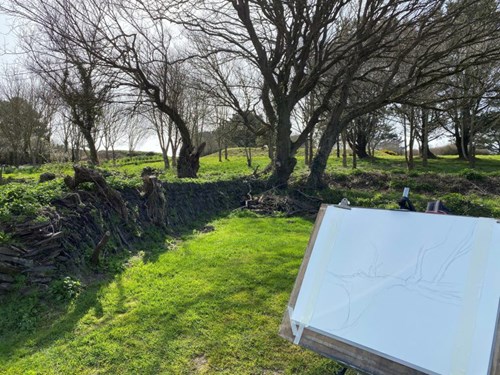
Walking our dog across the golf course during lockdown, I was captivated by the image of the bare black branches of the back lit winter trees and the glorious first signs of spring’s bright yellow daffodils. This appealed to me as the perfect subject to create with Derwent XL Charcoal Blocks and Inktense Paint Pans.
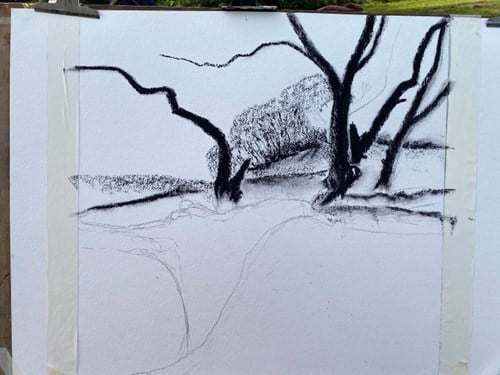
Gathering my supplies, I returned to the view a few days later and with a warm sun in my face offset by a cool breeze on my back, set up my easel. A few light marks with a charcoal pencil established the composition and I then I was able to jump in the with Black XL Charcoal block.
Having chosen a ‘rough’ watercolour paper for its texture I could create many different effects simply by the pressure and angle of application.
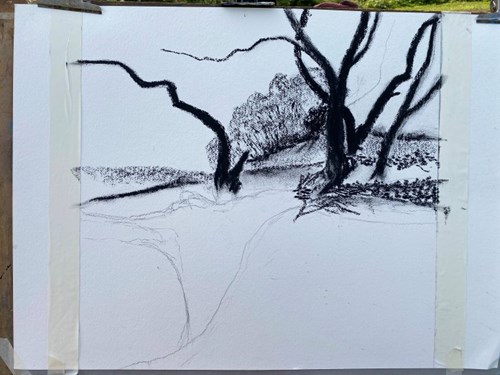
Using the long edge of the block, I lightly catch the surface to represent the distant bushes and land masses. Note how much darker it is under these distant bushes. The trunks of these are easily achieved by using the sharp edge at the end of the block in quick dashing strokes.
Different pressure establishes the darker areas of the background before blending forward with either your finger or a paper blending stump. At this stage the fascinatingly shaped very dark trees in the middle ground are added.
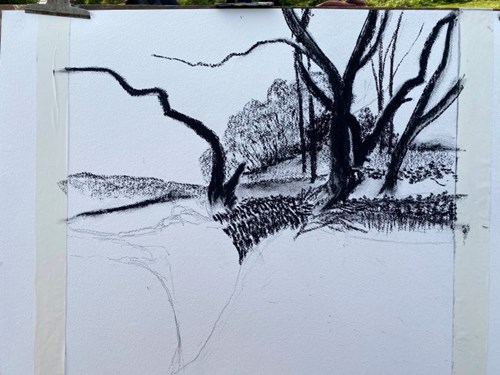
I find it valuable when using these blocks to wear a pair of latex gloves, preventing charcoal covered hands and finger nails difficult to clean.
Along with the fascinating tree forms, the old stone wall really appealed to me and in this next image you can see how I turned the block sideways on its edge to make representational marks, ensuring white gaps are left for effect.
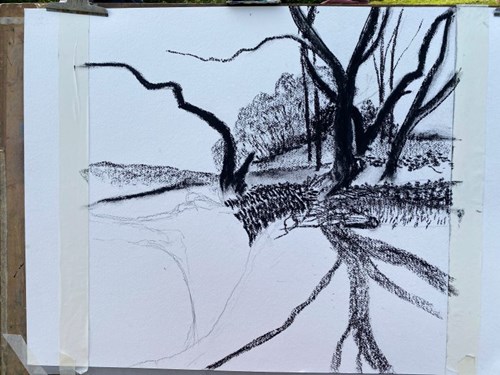
With the sun behind the subject, the long cast shadows create a natural line of visualisation through the painting, as can be seen in this image.
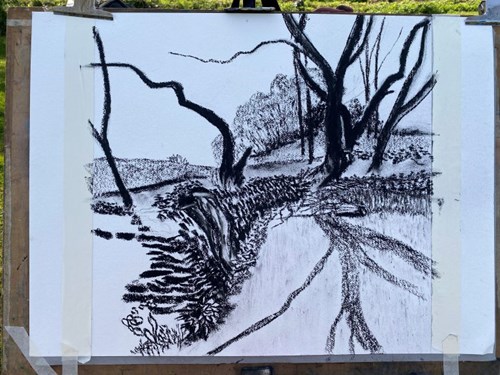
As the stone wall is drawn forward towards the left of the painting, it turns a corner giving yet more options to create interesting shapes. Also note how at the bottom of the nearby wall, leaves and flowers are represented by painting the negative shape very dark around them. To balance the foreground, lighter strokes with the side of the block are applied vertically and randomly then blended in. If you establish any of these too dark in the first instance (as I did) just use a hard eraser and cut back.
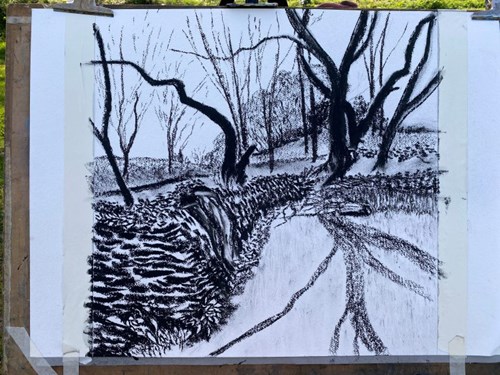
When introducing the smaller sapling trees, it’s a simple matter of observation for location and form and once the trunks are positioned, allowing freedom of light flicks to make the thinner higher branches. Note that you do not have to attach each twig to a branch or even a branch to a trunk. After drawing hundreds through the years en plein air, it becomes apparent that you do not actually see these finer details in reality.
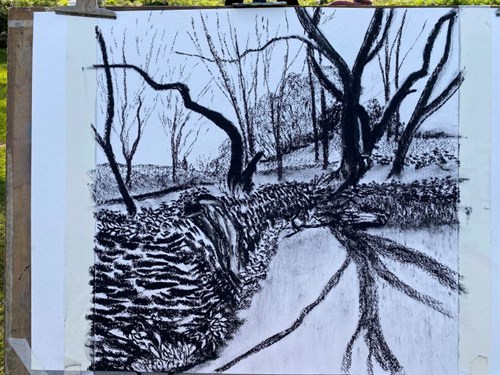
At this stage with the cool breeze starting to become a rather colder one, I felt it imperative to balance the tonal values before my hands would not work as wanted. I darkened some areas and lighten others by cutting back with an eraser. Then as it really was starting to get cold, making it uncomfortable to work, so I returned to my studio in Cornwall.
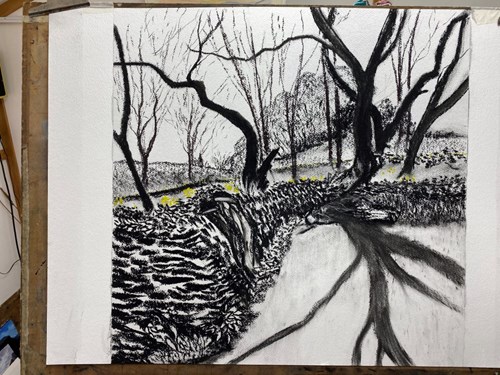
The first thing I expect you will notice is the different colour of the paper in this image. When photographing outdoors in natural daylight a blue cast appeared in the photograph. Which even I had never observed before, but once in my studio where I have carefully balanced natural lights installed, the photographs produced a truer colour.
My next step was to introduce the bright yellow daffodils of spring. These are painted with a Derwent Waterbrush and Inktense Paints.
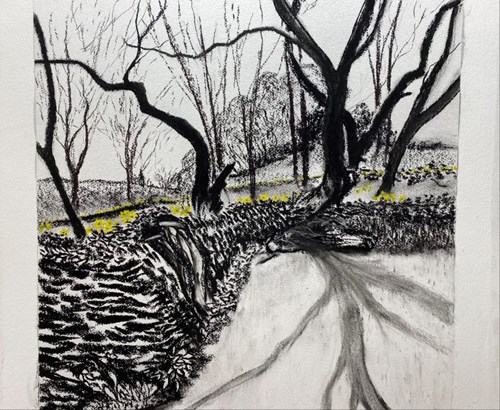
Whilst using the Sun Yellow colour from the Inktense Paint Studio Set and touching a spot of Hookers Green in the centre of the daffodils, it became apparent that the shadow of the tree was too dominant. Restricting the viewers eye from travelling through and around the painting. So by some quite heavy working with a firm eraser, I lighten them.
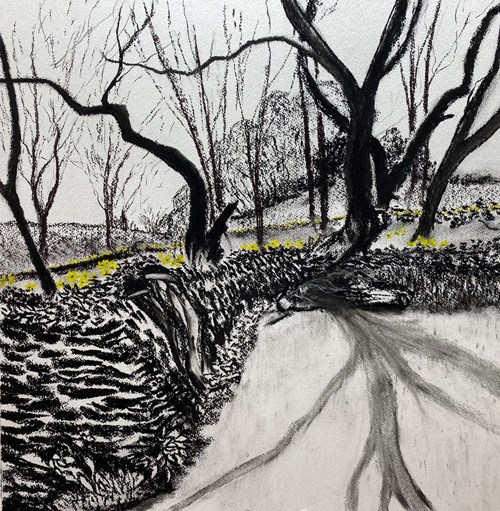
Finally the 58cm x 58cm work was complete and I knew my choice of the XL Charcoal Blocks and Inktense Paint Pan Set had provided the perfect mediums.
Thank you to Tony Hogan for providing this blog for us. You can discover more of Tony’s work on his Instagram, Facebook and website.